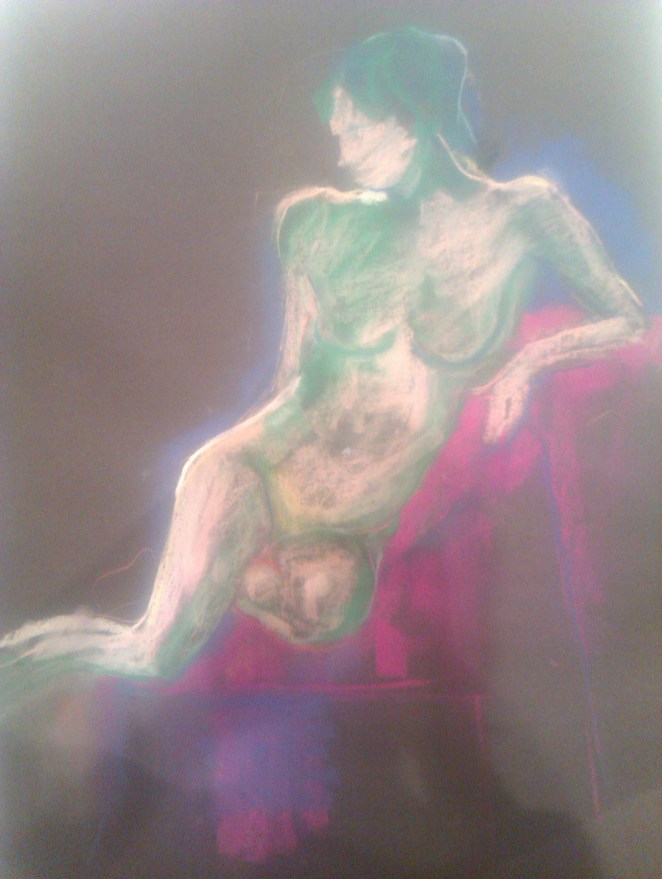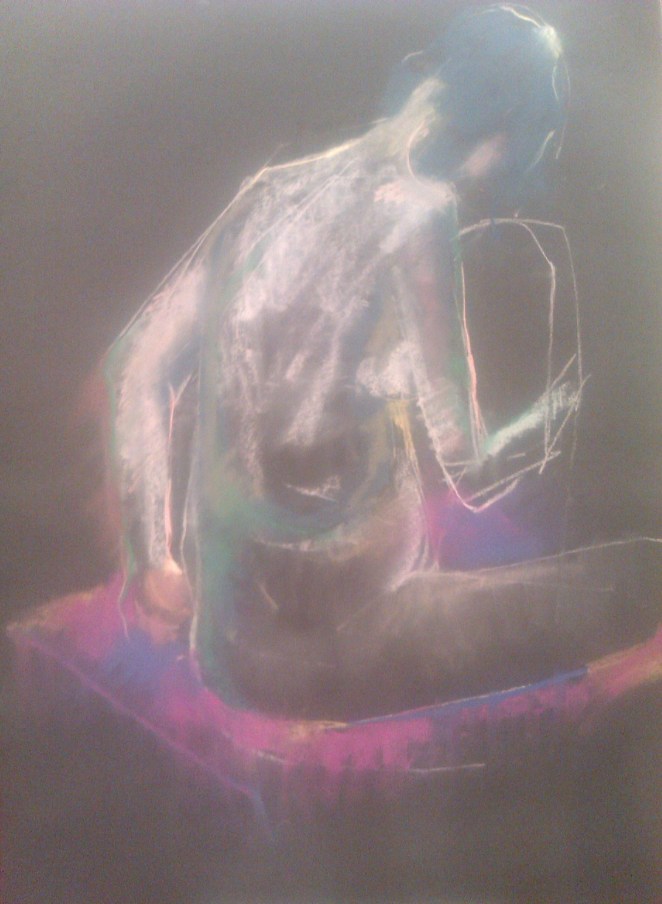Here are some pictures of recent poses I have done. If you are about to try life modelling for the 1st time and have not seen a model posing, this can give you some ideas for how to pose. It is a very individual activity however and must be necessarily adapted to suit each model.
These six 10 minute poses demonstrate some varieties of balance. One is leaning on a chair; there is one pose with weight distributed evenly between the legs; the others have most weight on one leg. The top left hand pose is a good example of a twist, whereby the body faces one direction lower down, then another further up. Artists tend to love a twist; it is a challenge, but also makes the pose more interesting and lets them see more of you from one position.

One leg up on the seat gives more levels to the pose. Arms leaning back makes the pose feel open and lends complementary triangles of negative space, shown here balancing the shape of the upward bent knee.

I am skinny so taking advantage of my angles works for me. Different body types do well to emphasize their features accordingly
Here my back is arched forward gently creating a different impression. My back naturally forms an ‘S’ shape which artists frequently want to draw. Posing to accentuate the ‘S’ however is not good for my back if done excessively. Sometimes I need to give it a break and rebalance by curving the other way. As a model it is vital to understand these needs of the body so you don’t over do it.
Negative space is the area in between which is not the body, and may be formed by limbs connecting with the body and creating a shape. Artists use particular measurements in a pose to relate to other lengths to help them achieve an accurate sense of proportion. They often hold a pencil up in line with a pose and with one eye open measure how much of the pencil length is taken up by the head for example. They then use that measurement to compare other details in the picture. The length of the head may be comparable to say that of the arm touching the knee.
Here is a post I wrote a while back about how particularly to pose in the group situation at Spirited Bodies;
http://spiritedbodies.com/2012/03/13/how-to-pose-guidelines-for-life-models-at-spirited-bodies/
That was for a previous event and I would like to add that on the forthcoming occasion – 21st July – there will be some shorter timed poses to warm up, from 5 to 15 minutes. Then there will be a period of freestyle posing when models may change pose when they prefer.
There will also be at least one timed half hour pose when I would like all models to remain still at the same time. This is good for feeling what life modelling is like, as well as giving artists a better chance of creating a good picture!
Also I have just found this http://jasonandthegoldenpose.wordpress.com/2012/07/04/finding-your-happy-place/#comment-103 which is the blog of a male model describing his experience as a life model. He’s got some good advice and covers many topics from what to think about whilst posing to what to expect financially from being an artist’s model.
Related articles
- MyMove™ – Yoga for Post Move Soreness (mymove.com)
- habitually (ecrisciyoga.com)
- Hold Your Pose… (cultivatingourselvestogether.com)
- Finding Your “Happy Place” (jasonandthegoldenpose.wordpress.com)







Really interesting to read about the poses from your perspective! I’ve noticed that a lot of the models I’ve drawn from have done a lot of twisted poses, which yes, I love to draw — but when I posed for my husband and did twisty poses he didn’t like it, because he felt like he never got to see my torso in its untwisted state!
I’ve never drawn a pose that felt boring; the human body is infinitely fascinating. But I find that the model’s energy/attitude brings a lot to the poses. Even an objectively interesting pose becomes duller when the model appears to be sleeping, bored, or not present. Likewise, a seemingly straightforward pose can become really intriguing when I can feel the model’s presence surging through it. Of course everyone gets tired over the course of a session, and I don’t mind when models close their eyes or need to rest — that’s not what I mean when I say they’re not present; it’s more that sometimes models show up with an attitude of “this is just a job to me” and they seem bored the whole way through, and then that’s not as fun. Still useful for practice, just not as dynamic.
LikeLike
Yes the energy is so important, thanks for bringing that up Lisa! Luckily models at Spirited Bodies are there because they really want to be as there is no money involved. They are often nervous and excited, and there are some professional life models in the mix too who are there because they love it 🙂 It’s good because those with experience share some confidence and expertise.
In a working situation how one is feeling as the model is critical, as it does project. Loving what you do makes all the difference, and most likely means you are more likely to get booked again.
Has your husband drawn a lot? I think simpler poses are preferable if one is new to drawing. In any case it would seem natural that he likes to see you as you are without complication! This reminds me it is high time my boyfriend drew me again hehe!
LikeLike
Yes! When the model isn’t present, it’s more of a one-way transaction, whereas an active, engaged model makes it feel more like an exchange (at least from my perspective as an artist). Really good models can change my energy completely, so that I can walk into the session feeling tired and walk out feeling like we did something meaningful. I’ve actually had an artist say to me that she prefers to draw nonmodels because they have more energy; I don’t agree, but I can see that first-time nonprofessionals would definitely project some really cool and interesting emotions. 🙂
Erik’s drawn a good deal but not much from live models, as the bulk of his drawing education happened when he was really young. I’ve been his main model since we got together, but more recently he’s started going to life drawing sessions with me, and that’s always fun!
LikeLike
It is indeed a lovely activity to share with one’s partner and I could do with trying some more drawing myself.
How invigorating when the drawing/modelling session can uplift a mood! I feel the same and for that reason find work can be like therapy in a good way.
LikeLike
very interesting and useful advice! Some of those poses must be pretty tricky to get into and hold when actually modelling especially if nervous in front of lots of people and in a group.
LikeLike
Good point; I am an experienced model and strike poses effortlessly. I wanted to get you thinking about what you could do when it comes to posing. The group (of models) can feel daunting and it can also feel supportive, I think you will find especially by the end. Also I will be there to encourage you and make suggestions. I know that when one is nervous and naked in front of artists then some ideas exit ones head! That’s why it’s a good idea to think about it in advance, maybe try some poses out at home in front of a mirror, or just in daily life. You could be waiting for a train, tying your shoelace, combing your hair or reaching for something high up. Experiment with more dynamic positions which look like they might be part of a dance, or as if you are in the middle of walking.
The more relaxed you are and free to create your own unique poses, the more likely artists will be to want to draw you.
This is why I sometimes hold a life modelling workshop in advance. Feel free to ask more along these lines; I think opening up this conversation is key to unlocking the way for you to model.
LikeLike